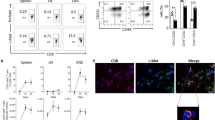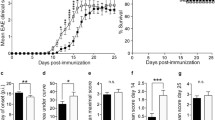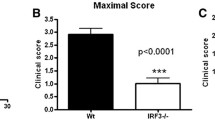Abstract
Apoptotic cell death plays a pivotal role in the development and/or maintenance of several tissues including thymus. Deregulated thymic cell death is associated with autoimmune diseases including experimental autoimmune encephalomyelitis (EAE), a prototype murine model for analysis of human multiple sclerosis. Because Thy28 expression is modulated during thymocyte development, we tested whether Thy28 affects induction of EAE as effectively as antigen-induced thymocyte deletion using Thy28 transgenic (TG) mice. Thy28 TG mice showed partial resistance to anti-CD3 monoclonal antibody (mAb)-induced thymic cell death in vivo, as assessed by annexin V-expression and loss of mitochondrial membrane potential. The resistance to anti-CD3 mAb-induced cell death in Thy28 TG mice appeared to correlate with a decreased c-Jun N-terminal kinase phosphorylation and reduced down-regulation of Bcl-xL. Moreover, thymic hyperplasia was detected in Thy28 TG mice, although thymocyte development was unaltered. Development of peripheral lymphoid tissues including spleen and lymph nodes was also unaltered. Thy28 TG spleen T cells showed an increased production of IFN-γ, but not IL-17, in response to both anti-CD3 and anti-CD28 mAbs. Finally, Thy28 TG mice displayed accelerated induction of EAE as assessed by disease incidence, clinical score, and pathology following immunization with myelin oligodendrocyte glycoprotein compared with control WT mice. These findings suggest that modulation of Thy28 expression plays a crucial role in the determination of thymic cell fate, which may contribute to the development of EAE through proinflammatory cytokine production.







Similar content being viewed by others
Abbreviations
- DP:
-
Double positive
- JNK:
-
c-Jun N-terminal kinase
- EAE:
-
Experimental autoimmune encephalomyelitis
- MS:
-
Multiple sclerosis
- MOG:
-
Myelin oligodendrocyte glycoprotein
- Th :
-
Helper T cell
- TG:
-
Transgenic
- WT:
-
Wild type
- MAb:
-
Monoclonal antibody
- MMP:
-
Mitochondrial membrane potential
- AP-1:
-
Activator protein 1
- CFA:
-
Complete Freund’s adjuvant
References
Sohn SJ, Rajpal A, Winoto A (2003) Apoptosis during lymphoid development. Curr Opin Immunol 15:209–216
von Boehmer H (1997) Aspects of lymphocyte developmental biology. Immunol Today 18:260–262
Reed JC (1998) Bcl-2 family proteins. Oncogene 17:3225–3236
Weston CR, Davis RJ (2002) The JNK signal transduction pathway. Curr Opin Genet Dev 12:14–21
Takada E, Hata K, Mizuguchi J (2006) Requirement for JNK-dependent upregulation of BimL in anti-IgM-induced apoptosis in murine B lymphoma cell lines WEHI-231 and CH31. Exp Cell Res 312:3728–3738
Susin SA, Zamzami N, Kroemer G (1998) Mitochondria as regulators of apoptosis: doubt no more. Biochim Biophys Acta 1366:151–165
Hildeman DA, Mitchell T, Teague TK et al (1999) Reactive oxygen species regulate activation-induced T cell apoptosis. Immunity 10:735–744
Roger J, Chalifour A, Lemieux S, Duplay P (2001) Cutting edge: Ly49A inhibits TCR/CD3-induced apoptosis and IL-2 secretion. J Immunol 167:6–10
Zinkel S, Gross A, Yang E (2006) BCL2 family in DNA damage and cell cycle control. Cell Death Differ 13:1351–1359
Dong C, Davis RJ, Flavell RA (2002) MAP kinases in the immune response. Annu Rev Immunol 20:55–72
Minden A, Karin M (1997) Regulation and function of the JNK subgroup of MAP kinases. Biochim Biophys Acta 1333:F85–F104
Xia Z, Dickens M, Raingeaud J, Davis RJ, Greenberg ME (1995) Opposing effects of ERK and JNK-p38 MAP kinases on apoptosis. Science 270:1326–1331
Sabapathy K, Kallunki T, David JP, Graef I, Karin M, Wagner EF (2001) c-Jun NH2-terminal kinase (JNK)1 and JNK2 have similar and stage-dependent roles in regulating T cell apoptosis and proliferation. J Exp Med 193:317–328
Baxter AG (2007) The origin and application of experimental autoimmune encephalomyelitis. Nat Rev Immunol 7:904–912
Gold R, Linington C, Lassmann H (2006) Understanding pathogenesis and therapy of multiple sclerosis via animal models: 70 years of merits and culprits in experimental autoimmune encephalomyelitis research. Brain 129:1953–1971
Steinman L (2007) A brief history of T(H)17, the first major revision in the T(H)1/T(H)2 hypothesis of T cell-mediated tissue damage. Nat Med 13:139–145
Petermann F, Korn T (2011) Cytokines and effector T cell subsets causing autoimmune CNS disease. FEBS Lett 585:3747–3757
Lees JR, Golumbek PT, Sim J, Dorsey D, Russell JH (2008) Regional CNS responses to IFN-gamma determine lesion localization patterns during EAE pathogenesis. J Exp Med 205:2633–2642
Chu CQ, Wittmer S, Dalton DK (2000) Failure to suppress the expansion of the activated CD4 T cell population in interferon gamma-deficient mice leads to exacerbation of experimental autoimmune encephalomyelitis. J Exp Med 192:123–128
Sutton C, Brereton C, Keogh B, Mills KH, Lavelle EC (2006) A crucial role for interleukin (IL)-1 in the induction of IL-17-producing T cells that mediate autoimmune encephalomyelitis. J Exp Med 203:1685–1691
Park H, Li Z, Yang XO et al (2005) A distinct lineage of CD4 T cells regulates tissue inflammation by producing interleukin 17. Nat Immunol 6:1133–1141
Miyaji H, Yoshimoto T, Asakura H et al (2002) Molecular cloning and characterization of the mouse thymocyte protein gene. Gene 297:189–196
Jiang XZ, Toyota H, Yoshimoto T, Takada E, Asakura H, Mizuguchi J (2003) Anti-IgM-induced down-regulation of nuclear Thy28 protein expression in Ramos B lymphoma cells. Apoptosis 8:509–519
Jiang X, Toyota H, Takada E et al (2003) Modulation of mThy28 nuclear protein expression during thymocyte development. Tissue Cell 35:471–478
Toyota H, Jiang XZ, Asakura H, Mizuguchi J (2012) Thy28 partially prevents apoptosis induction following engagement of membrane immunoglobulin in WEHI-231 B lymphoma cells. Cell Mol Biol Lett 17:36–48
Toyota H, Yanase N, Yoshimoto T, Moriyama M, Sudo T, Mizuguchi J (2003) Calpain-induced Bax-cleavage product is a more potent inducer of apoptotic cell death than wild-type Bax. Cancer Lett 189:221–230
Furuhata M, Takada E, Noguchi T, Ichijo H, Mizuguchi J (2009) Apoptosis signal-regulating kinase (ASK)-1 mediates apoptosis through activation of JNK1 following engagement of membrane immunoglobulin. Exp Cell Res 315:3467–3476
Vermes I, Haanen C, Reutelingsperger C (2000) Flow cytometry of apoptotic cell death. J Immunol Methods 243:167–190
Cao Y, Takada E, Hata K, Sudo K, Furuhata M, Mizuguchi J (2010) Enhanced T cell-independent antibody responses in c-Jun N-terminal kinase 2 (JNK2)-deficient B cells following stimulation with CpG-1826 and anti-IgM. Immunol Lett 132:38–44
Smith CA, Williams GT, Kingston R, Jenkinson EJ, Owen JJ (1989) Antibodies to CD3/T-cell receptor complex induce death by apoptosis in immature T cells in thymic cultures. Nature 337:181–184
Shi YF, Sahai BM, Green DR (1989) Cyclosporin A inhibits activation-induced cell death in T-cell hybridomas and thymocytes. Nature 339:625–626
Bassiri H, Carding SR (2001) A requirement for IL-2/IL-2 receptor signaling in intrathymic negative selection. J Immunol 166:5945–5954
Baccala R, Kono DH, Theofilopoulos AN (2005) Interferons as pathogenic effectors in autoimmunity. Immunol Rev 204:9–26
Cope A, Le Friec G, Cardone J, Kemper C (2011) The Th1 life cycle: molecular control of IFN-gamma to IL-10 switching. Trends Immunol 32:278–286
Patel VA, Lee DJ, Longacre-Antoni A et al (2009) Apoptotic and necrotic cells as sentinels of local tissue stress and inflammation: response pathways initiated in nearby viable cells. Autoimmunity 42:317–321
Lleo A, Selmi C, Invernizzi P, Podda M, Gershwin ME (2008) The consequences of apoptosis in autoimmunity. J Autoimmun 31:257–262
McConkey DJ, Hartzell P, Amador-Perez JF, Orrenius S, Jondal M (1989) Calcium-dependent killing of immature thymocytes by stimulation via the CD3/T cell receptor complex. J Immunol 143:1801–1806
Volkmann A, Doffinger R, Ruther U, Kyewski BA (1996) Insertional mutagenesis affecting programmed cell death leads to thymic hyperplasia and altered thymopoiesis. J Immunol 156:136–145
Sherer Y, Bardayan Y, Shoenfeld Y (1997) Thymoma, thymic hyperplasia, thymectomy and autoimmune diseases (Review). Int J Oncol 10:939–943
Gatzka M, Walsh CM (2007) Apoptotic signal transduction and T cell tolerance. Autoimmunity 40:442–452
Ercolini AM, Miller SD (2006) Mechanisms of immunopathology in murine models of central nervous system demyelinating disease. J Immunol 176:3293–3298
Acknowledgments
We thank Dr. K. Miyake (Department of Biochemistry and Molecular Biology, Nippon Medical School, Tokyo, Japan) for pCAGGS vector. This work was supported by a Grant from the Intractable Immune System Disease Center of Tokyo Medical University, which is supported by the Ministry of Education, Culture, Sports, Science, and Technology of Japan. We also thank Zenji Sakamoto for his support.
Conflict of interest
We declare no conflicts of interest.
Author information
Authors and Affiliations
Corresponding author
Electronic supplementary material
Below is the link to the electronic supplementary material.
S1
Thy28 expression in Thy28-121 TG mice. Thy28 mRNA expression levels from Thy28 TG and control individual mice were determined by RT-PCR. Expression levels of GAPDH were also determined as control. The data are representative of three independent experiments. (PPTX 12 kb)
S2
Anti-CD3 mAb-induced reduction in proportion of DP thymocytes is abrogated in Thy28-121 TG mice. The percentage of DP cells from Thy28-121 or control mice after administration of 10 μg anti-CD3 mAb or control PBS was enumerated. The data are representative of three independent experiments. (PPTX 109 kb)
S3
Thy28-121 TG mice demonstrate an augmented clinical score, accompanied by increased cell infiltration and demyelination relative to control mice following MOG administration. (A) Thy28-121 TG (n=10) and control WT mice (n=10) were immunized with MOG and assessed by clinical score every 1–3 day up to day 25. (B) In a separate experiment, Thy28 TG (b and d, n=5) and WT mice (a and c, n=5) were assessed by disease incidence, clinical score, and pathology on day 25 after MOG immunization. Spinal sections stained with H & E (a and b) and Luxol fast blue (c and d). The location of cellular infiltration (b) and myelin sheath (d) was shown by arrows. (PPTX 128 kb)
Rights and permissions
About this article
Cite this article
Toyota, H., Sudo, K., Kojima, K. et al. Thy28 protects against anti-CD3-mediated thymic cell death in vivo. Apoptosis 20, 444–454 (2015). https://doi.org/10.1007/s10495-014-1082-0
Published:
Issue Date:
DOI: https://doi.org/10.1007/s10495-014-1082-0




